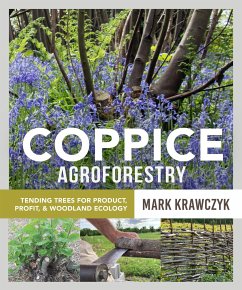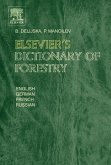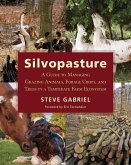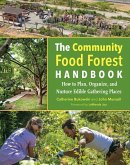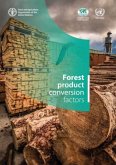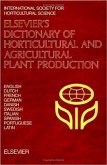- Broschiertes Buch
- Merkliste
- Auf die Merkliste
- Bewerten Bewerten
- Teilen
- Produkt teilen
- Produkterinnerung
- Produkterinnerung
Coppice Agroforestry is a comprehensive guide to resprout silviculture â coppicing, pollarding, shredding, and pleaching hardwood trees for firewood, building materials, furniture, basketry, and more. Covers coppice history, biology, ecology, products, woodland economics, and agroforestry system design and management.
Andere Kunden interessierten sich auch für
![Elsevier's Dictionary of Forestry Elsevier's Dictionary of Forestry]() B. DelijskaElsevier's Dictionary of Forestry348,99 €
B. DelijskaElsevier's Dictionary of Forestry348,99 €![Plant Science for Gardeners Plant Science for Gardeners]() Robert PavlisPlant Science for Gardeners21,99 €
Robert PavlisPlant Science for Gardeners21,99 €![Silvopasture Silvopasture]() Steve GabrielSilvopasture39,99 €
Steve GabrielSilvopasture39,99 €![The Community Food Forest Handbook The Community Food Forest Handbook]() Catherine BukowskiThe Community Food Forest Handbook27,99 €
Catherine BukowskiThe Community Food Forest Handbook27,99 €![Compilation of Notes on the Most Important Timber Tree Species of the Philippine Islands Compilation of Notes on the Most Important Timber Tree Species of the Philippine Islands]() George Patrick 1859-1942 AhernCompilation of Notes on the Most Important Timber Tree Species of the Philippine Islands37,99 €
George Patrick 1859-1942 AhernCompilation of Notes on the Most Important Timber Tree Species of the Philippine Islands37,99 €![Forest Product Conversion Factors Forest Product Conversion Factors]() Food and Agriculture OrganizationForest Product Conversion Factors50,99 €
Food and Agriculture OrganizationForest Product Conversion Factors50,99 €![Elsevier's Dictionary of Horticultural and Agricultural Plant Production Elsevier's Dictionary of Horticultural and Agricultural Plant Production]() Jason HortElsevier's Dictionary of Horticultural and Agricultural Plant Production431,99 €
Jason HortElsevier's Dictionary of Horticultural and Agricultural Plant Production431,99 €-
-
-
Coppice Agroforestry is a comprehensive guide to resprout silviculture â coppicing, pollarding, shredding, and pleaching hardwood trees for firewood, building materials, furniture, basketry, and more. Covers coppice history, biology, ecology, products, woodland economics, and agroforestry system design and management.
Hinweis: Dieser Artikel kann nur an eine deutsche Lieferadresse ausgeliefert werden.
Hinweis: Dieser Artikel kann nur an eine deutsche Lieferadresse ausgeliefert werden.
Produktdetails
- Produktdetails
- Verlag: New Society Publishers
- Seitenzahl: 576
- Erscheinungstermin: 5. Juli 2022
- Englisch
- Abmessung: 224mm x 193mm x 37mm
- Gewicht: 1152g
- ISBN-13: 9780865719705
- ISBN-10: 0865719705
- Artikelnr.: 62427913
- Herstellerkennzeichnung
- Produktsicherheitsverantwortliche/r
- Europaallee 1
- 36244 Bad Hersfeld
- gpsr@libri.de
- Verlag: New Society Publishers
- Seitenzahl: 576
- Erscheinungstermin: 5. Juli 2022
- Englisch
- Abmessung: 224mm x 193mm x 37mm
- Gewicht: 1152g
- ISBN-13: 9780865719705
- ISBN-10: 0865719705
- Artikelnr.: 62427913
- Herstellerkennzeichnung
- Produktsicherheitsverantwortliche/r
- Europaallee 1
- 36244 Bad Hersfeld
- gpsr@libri.de
Mark Krawczyk owns and operates Keyline Vermont LLC, teaching, designing, and consulting on permaculture design, agroforestry, natural building, traditional woodworking, and small-scale forestry for farmers, homeowners, and homesteaders. He and his wife manage Valley Clayplain Forest Farm in New Haven, Vermont.
Dedication
Acknowledgments
Preface
Foreword
Introduction: What Is Coppice?
What Is It?
Dissecting Our Definition
Why Coppice?
Why Is It Nonexistent Here?
Why Do It Today?
Home and Community Scale Energy Security
Local Livelihoods and a Culture of Craft
Preserving Native Forests
Leaving a Legacy
Why Not?
Purpose of This Book
PART 1: HISTORY, BIOLOGY, SYSTEMS, AND ECONOMY
Chapter 1: A Cultural History of Coppice Agroforestry
Coppice: An Essential Prehistoric Resource
The Landscapes of Prehistoric Europe and Early Evidence of Coppice
Resprouts in Pre-contact North America
Coppice in Europe: From Subsistence Resource to Market Commodity
Roman Legacies: Industrial-scale Copses and Sweet Chestnut
Medieval Woodlands: Composition, Patterns, and Protection
The Manorial System: Private Ownership and Wooded Commons
Coppice in the Emerging Market Economy
Charcoal for Industry Boosts Coppice Production
Shifting Products, Markets, and Management
The Near Extinction of Coppicing
The Rise of Modern Forestry
Coppice in Colonial and Industrial North America?
Revival? Coppicing for the 22nd Century
European Revival
Recapitulation: Crafting Regenerative Resprout Silviculture
Chapter 2: The Anatomy and Physiology of Woody Plants
Woody Plant Organs and Tissues
Primary Organs: Crown, Trunk, and Roots
Woody Plant Forms: Overall Aboveground Architecture
Meristems: Tissues Capable of Division
Wood and Bark: Tissues of the Trunk
Tree Growth, Development, Life Span, and Decay
Generalized Growth Pattern: Nested Cones
Woody Plant Growth Habits: Above- and Belowground
Plant Growth Patterns
The Timing and Pattern of Seasonal Growth
Tree Health and Life Span: An Energetic Balancing Act
Sprouts and Resprouts
The Adaptive Utility of the Ability to Resprout
Anatomy and Physiology of Angiosperm Sprouting
Conclusion
Chapter 3: Ecology of Coppice Systems
The Economy of Forest Ecosystems
Natural Communities and Forest Cover Types
Effects of Coppice on Community Ecology and Biodiversity
Key Differences Between Coppice and High Forest
Forest Growth Stages
Forest Gap Formation
Effects of Disturbance on Ground Layer Populations
Growth Stages and Microclimate
Effects of Access Rides and Woodland Roadways
Coppice and Bird Species
Coppice and Small Mammal Populations
Coppice and Deer
Coppice and Invertebrates
Butterflies
Deadwood
Nutrient Dynamics in Coppice Woods
Soil-Water Dynamics
A Conservation Panacea?
Chapter 4: Woodland Management Systems
Systems Framework
Species
Economy
Disturbance Severity
Disturbance Chronology
Landscape Pattern
Resprout Silviculture Systems both Historic and Modern
Adding Trees to Fields
Woodland-based Systems
Other Types of Resprout Silviculture
Shredding
Stooling
Own-root Fruit Trees
Stump Culture or Coppiced Christmas Trees
Silvicultural Foundations of High Forest Management
High Forest Management Systems
Putting it All Together: Choosing the Right System for Your Landscape and
Needs
Chapter 5: Coppice Economics and Products
Markets
The Value-added Continuum
Business Development
Working Along the Value-added Continuum from Low to High
Woodchips: Biofuel, Soil-improving Mulches, Woodchip-Clay
Fodder
Fuelwood
Faggots
Charcoal
Carbon Farming
Garden Products
Holiday Ornamentation
Culinary and Medicinal Mushrooms
Food/Medicine/Wine
Fencing
Shelterbelts/Windbreaks/Soundbreaks
Hedges
Specialized Traditional Crafts
Baskets
Rustic Furniture
Green Woodworking
Building and Construction Materials
Buildings
Modern Product Potential
Matching Production Systems to Regional Climate and Production Needs
Financial Assistance to Support Coppice Management
Forestry Cooperatives
Conclusion
PART II: 21st CENTURY COPPICE: A MODERN INTEGRATION
Chapter 6: Listening to the Land: The Art of Ecological Design
A Synthesis of Strategies
The Silvicultural Standard: Forest Management Plans
Working with a Professional: The Role of Foresters
Goals and Management Objectives
Mapping
GIS Mapping
Mapping Forest Stands
Site Analysis
Yeomans' Scale of Permanence
Stand-specific Assessments
System Design
Cant Size, Rotation Length, and Layout
The Circulatory System: Access and Extraction Routes
Water Sources and Supply
Fodder and Fence System Design
Basket Willow Systems
Managing for Wildlife
A Coppice Pattern Language: Design Details and Criteria
Designing Cultivated Ecologies: Multistoried, Multifunctional Guild Design
Temporal Design: Cant Establishment and Harvest Schedules
Putting Down the Pencil and Picking Up the Shovel
Chapter 7: Getting Started: Establishing Coppice on Your Land
Woodland Conversion
Existing Stand Dynamics and Their Effects on Cant Development
Natural Regeneration: Restocking Forest Stands
Prescribed Burns
Conclusion
Field Transformation
Species
Layout and Spacing
Ground Prep
Planting Techniques
Planting a Hedgerow
Maintenance and Protection
Tree Shelters
Irrigation
Projecting Costs
Keeping Records Is Key
Chapter 8: Coppice Management and Harvest
First Harvest Cycle: Coppice Establishment
When to Cut
Where to Cut
When to Initiate Coppicing
Pollarding
Preparing a Tree for Pollarding
How and Where to Cut
Accessing and Harvesting Pollards
Timing
Disturbance Chronology
Managing Hedgerows
The Art of Hedgelaying
Tools and Felling Techniques
Specialized Pollarding Tools
Felling
Snedding or Limbing
Cross-cutting and Product Selection
Extraction
Storing Products
Cant Management
Maintenance Inputs
Stand Improvement
Pest and Weed Control
Access
Restoring Overstood Coppice
Epilogue
Appendix 1: Additional Resources
Appendix 2: Yield and Species-by-Use Tables
Species-by-Use Table Bibliography
Endnotes
Glossary
Bibliography
Index
About the Author
A Note About the Publisher
Acknowledgments
Preface
Foreword
Introduction: What Is Coppice?
What Is It?
Dissecting Our Definition
Why Coppice?
Why Is It Nonexistent Here?
Why Do It Today?
Home and Community Scale Energy Security
Local Livelihoods and a Culture of Craft
Preserving Native Forests
Leaving a Legacy
Why Not?
Purpose of This Book
PART 1: HISTORY, BIOLOGY, SYSTEMS, AND ECONOMY
Chapter 1: A Cultural History of Coppice Agroforestry
Coppice: An Essential Prehistoric Resource
The Landscapes of Prehistoric Europe and Early Evidence of Coppice
Resprouts in Pre-contact North America
Coppice in Europe: From Subsistence Resource to Market Commodity
Roman Legacies: Industrial-scale Copses and Sweet Chestnut
Medieval Woodlands: Composition, Patterns, and Protection
The Manorial System: Private Ownership and Wooded Commons
Coppice in the Emerging Market Economy
Charcoal for Industry Boosts Coppice Production
Shifting Products, Markets, and Management
The Near Extinction of Coppicing
The Rise of Modern Forestry
Coppice in Colonial and Industrial North America?
Revival? Coppicing for the 22nd Century
European Revival
Recapitulation: Crafting Regenerative Resprout Silviculture
Chapter 2: The Anatomy and Physiology of Woody Plants
Woody Plant Organs and Tissues
Primary Organs: Crown, Trunk, and Roots
Woody Plant Forms: Overall Aboveground Architecture
Meristems: Tissues Capable of Division
Wood and Bark: Tissues of the Trunk
Tree Growth, Development, Life Span, and Decay
Generalized Growth Pattern: Nested Cones
Woody Plant Growth Habits: Above- and Belowground
Plant Growth Patterns
The Timing and Pattern of Seasonal Growth
Tree Health and Life Span: An Energetic Balancing Act
Sprouts and Resprouts
The Adaptive Utility of the Ability to Resprout
Anatomy and Physiology of Angiosperm Sprouting
Conclusion
Chapter 3: Ecology of Coppice Systems
The Economy of Forest Ecosystems
Natural Communities and Forest Cover Types
Effects of Coppice on Community Ecology and Biodiversity
Key Differences Between Coppice and High Forest
Forest Growth Stages
Forest Gap Formation
Effects of Disturbance on Ground Layer Populations
Growth Stages and Microclimate
Effects of Access Rides and Woodland Roadways
Coppice and Bird Species
Coppice and Small Mammal Populations
Coppice and Deer
Coppice and Invertebrates
Butterflies
Deadwood
Nutrient Dynamics in Coppice Woods
Soil-Water Dynamics
A Conservation Panacea?
Chapter 4: Woodland Management Systems
Systems Framework
Species
Economy
Disturbance Severity
Disturbance Chronology
Landscape Pattern
Resprout Silviculture Systems both Historic and Modern
Adding Trees to Fields
Woodland-based Systems
Other Types of Resprout Silviculture
Shredding
Stooling
Own-root Fruit Trees
Stump Culture or Coppiced Christmas Trees
Silvicultural Foundations of High Forest Management
High Forest Management Systems
Putting it All Together: Choosing the Right System for Your Landscape and
Needs
Chapter 5: Coppice Economics and Products
Markets
The Value-added Continuum
Business Development
Working Along the Value-added Continuum from Low to High
Woodchips: Biofuel, Soil-improving Mulches, Woodchip-Clay
Fodder
Fuelwood
Faggots
Charcoal
Carbon Farming
Garden Products
Holiday Ornamentation
Culinary and Medicinal Mushrooms
Food/Medicine/Wine
Fencing
Shelterbelts/Windbreaks/Soundbreaks
Hedges
Specialized Traditional Crafts
Baskets
Rustic Furniture
Green Woodworking
Building and Construction Materials
Buildings
Modern Product Potential
Matching Production Systems to Regional Climate and Production Needs
Financial Assistance to Support Coppice Management
Forestry Cooperatives
Conclusion
PART II: 21st CENTURY COPPICE: A MODERN INTEGRATION
Chapter 6: Listening to the Land: The Art of Ecological Design
A Synthesis of Strategies
The Silvicultural Standard: Forest Management Plans
Working with a Professional: The Role of Foresters
Goals and Management Objectives
Mapping
GIS Mapping
Mapping Forest Stands
Site Analysis
Yeomans' Scale of Permanence
Stand-specific Assessments
System Design
Cant Size, Rotation Length, and Layout
The Circulatory System: Access and Extraction Routes
Water Sources and Supply
Fodder and Fence System Design
Basket Willow Systems
Managing for Wildlife
A Coppice Pattern Language: Design Details and Criteria
Designing Cultivated Ecologies: Multistoried, Multifunctional Guild Design
Temporal Design: Cant Establishment and Harvest Schedules
Putting Down the Pencil and Picking Up the Shovel
Chapter 7: Getting Started: Establishing Coppice on Your Land
Woodland Conversion
Existing Stand Dynamics and Their Effects on Cant Development
Natural Regeneration: Restocking Forest Stands
Prescribed Burns
Conclusion
Field Transformation
Species
Layout and Spacing
Ground Prep
Planting Techniques
Planting a Hedgerow
Maintenance and Protection
Tree Shelters
Irrigation
Projecting Costs
Keeping Records Is Key
Chapter 8: Coppice Management and Harvest
First Harvest Cycle: Coppice Establishment
When to Cut
Where to Cut
When to Initiate Coppicing
Pollarding
Preparing a Tree for Pollarding
How and Where to Cut
Accessing and Harvesting Pollards
Timing
Disturbance Chronology
Managing Hedgerows
The Art of Hedgelaying
Tools and Felling Techniques
Specialized Pollarding Tools
Felling
Snedding or Limbing
Cross-cutting and Product Selection
Extraction
Storing Products
Cant Management
Maintenance Inputs
Stand Improvement
Pest and Weed Control
Access
Restoring Overstood Coppice
Epilogue
Appendix 1: Additional Resources
Appendix 2: Yield and Species-by-Use Tables
Species-by-Use Table Bibliography
Endnotes
Glossary
Bibliography
Index
About the Author
A Note About the Publisher
Dedication
Acknowledgments
Preface
Foreword
Introduction: What Is Coppice?
What Is It?
Dissecting Our Definition
Why Coppice?
Why Is It Nonexistent Here?
Why Do It Today?
Home and Community Scale Energy Security
Local Livelihoods and a Culture of Craft
Preserving Native Forests
Leaving a Legacy
Why Not?
Purpose of This Book
PART 1: HISTORY, BIOLOGY, SYSTEMS, AND ECONOMY
Chapter 1: A Cultural History of Coppice Agroforestry
Coppice: An Essential Prehistoric Resource
The Landscapes of Prehistoric Europe and Early Evidence of Coppice
Resprouts in Pre-contact North America
Coppice in Europe: From Subsistence Resource to Market Commodity
Roman Legacies: Industrial-scale Copses and Sweet Chestnut
Medieval Woodlands: Composition, Patterns, and Protection
The Manorial System: Private Ownership and Wooded Commons
Coppice in the Emerging Market Economy
Charcoal for Industry Boosts Coppice Production
Shifting Products, Markets, and Management
The Near Extinction of Coppicing
The Rise of Modern Forestry
Coppice in Colonial and Industrial North America?
Revival? Coppicing for the 22nd Century
European Revival
Recapitulation: Crafting Regenerative Resprout Silviculture
Chapter 2: The Anatomy and Physiology of Woody Plants
Woody Plant Organs and Tissues
Primary Organs: Crown, Trunk, and Roots
Woody Plant Forms: Overall Aboveground Architecture
Meristems: Tissues Capable of Division
Wood and Bark: Tissues of the Trunk
Tree Growth, Development, Life Span, and Decay
Generalized Growth Pattern: Nested Cones
Woody Plant Growth Habits: Above- and Belowground
Plant Growth Patterns
The Timing and Pattern of Seasonal Growth
Tree Health and Life Span: An Energetic Balancing Act
Sprouts and Resprouts
The Adaptive Utility of the Ability to Resprout
Anatomy and Physiology of Angiosperm Sprouting
Conclusion
Chapter 3: Ecology of Coppice Systems
The Economy of Forest Ecosystems
Natural Communities and Forest Cover Types
Effects of Coppice on Community Ecology and Biodiversity
Key Differences Between Coppice and High Forest
Forest Growth Stages
Forest Gap Formation
Effects of Disturbance on Ground Layer Populations
Growth Stages and Microclimate
Effects of Access Rides and Woodland Roadways
Coppice and Bird Species
Coppice and Small Mammal Populations
Coppice and Deer
Coppice and Invertebrates
Butterflies
Deadwood
Nutrient Dynamics in Coppice Woods
Soil-Water Dynamics
A Conservation Panacea?
Chapter 4: Woodland Management Systems
Systems Framework
Species
Economy
Disturbance Severity
Disturbance Chronology
Landscape Pattern
Resprout Silviculture Systems both Historic and Modern
Adding Trees to Fields
Woodland-based Systems
Other Types of Resprout Silviculture
Shredding
Stooling
Own-root Fruit Trees
Stump Culture or Coppiced Christmas Trees
Silvicultural Foundations of High Forest Management
High Forest Management Systems
Putting it All Together: Choosing the Right System for Your Landscape and
Needs
Chapter 5: Coppice Economics and Products
Markets
The Value-added Continuum
Business Development
Working Along the Value-added Continuum from Low to High
Woodchips: Biofuel, Soil-improving Mulches, Woodchip-Clay
Fodder
Fuelwood
Faggots
Charcoal
Carbon Farming
Garden Products
Holiday Ornamentation
Culinary and Medicinal Mushrooms
Food/Medicine/Wine
Fencing
Shelterbelts/Windbreaks/Soundbreaks
Hedges
Specialized Traditional Crafts
Baskets
Rustic Furniture
Green Woodworking
Building and Construction Materials
Buildings
Modern Product Potential
Matching Production Systems to Regional Climate and Production Needs
Financial Assistance to Support Coppice Management
Forestry Cooperatives
Conclusion
PART II: 21st CENTURY COPPICE: A MODERN INTEGRATION
Chapter 6: Listening to the Land: The Art of Ecological Design
A Synthesis of Strategies
The Silvicultural Standard: Forest Management Plans
Working with a Professional: The Role of Foresters
Goals and Management Objectives
Mapping
GIS Mapping
Mapping Forest Stands
Site Analysis
Yeomans' Scale of Permanence
Stand-specific Assessments
System Design
Cant Size, Rotation Length, and Layout
The Circulatory System: Access and Extraction Routes
Water Sources and Supply
Fodder and Fence System Design
Basket Willow Systems
Managing for Wildlife
A Coppice Pattern Language: Design Details and Criteria
Designing Cultivated Ecologies: Multistoried, Multifunctional Guild Design
Temporal Design: Cant Establishment and Harvest Schedules
Putting Down the Pencil and Picking Up the Shovel
Chapter 7: Getting Started: Establishing Coppice on Your Land
Woodland Conversion
Existing Stand Dynamics and Their Effects on Cant Development
Natural Regeneration: Restocking Forest Stands
Prescribed Burns
Conclusion
Field Transformation
Species
Layout and Spacing
Ground Prep
Planting Techniques
Planting a Hedgerow
Maintenance and Protection
Tree Shelters
Irrigation
Projecting Costs
Keeping Records Is Key
Chapter 8: Coppice Management and Harvest
First Harvest Cycle: Coppice Establishment
When to Cut
Where to Cut
When to Initiate Coppicing
Pollarding
Preparing a Tree for Pollarding
How and Where to Cut
Accessing and Harvesting Pollards
Timing
Disturbance Chronology
Managing Hedgerows
The Art of Hedgelaying
Tools and Felling Techniques
Specialized Pollarding Tools
Felling
Snedding or Limbing
Cross-cutting and Product Selection
Extraction
Storing Products
Cant Management
Maintenance Inputs
Stand Improvement
Pest and Weed Control
Access
Restoring Overstood Coppice
Epilogue
Appendix 1: Additional Resources
Appendix 2: Yield and Species-by-Use Tables
Species-by-Use Table Bibliography
Endnotes
Glossary
Bibliography
Index
About the Author
A Note About the Publisher
Acknowledgments
Preface
Foreword
Introduction: What Is Coppice?
What Is It?
Dissecting Our Definition
Why Coppice?
Why Is It Nonexistent Here?
Why Do It Today?
Home and Community Scale Energy Security
Local Livelihoods and a Culture of Craft
Preserving Native Forests
Leaving a Legacy
Why Not?
Purpose of This Book
PART 1: HISTORY, BIOLOGY, SYSTEMS, AND ECONOMY
Chapter 1: A Cultural History of Coppice Agroforestry
Coppice: An Essential Prehistoric Resource
The Landscapes of Prehistoric Europe and Early Evidence of Coppice
Resprouts in Pre-contact North America
Coppice in Europe: From Subsistence Resource to Market Commodity
Roman Legacies: Industrial-scale Copses and Sweet Chestnut
Medieval Woodlands: Composition, Patterns, and Protection
The Manorial System: Private Ownership and Wooded Commons
Coppice in the Emerging Market Economy
Charcoal for Industry Boosts Coppice Production
Shifting Products, Markets, and Management
The Near Extinction of Coppicing
The Rise of Modern Forestry
Coppice in Colonial and Industrial North America?
Revival? Coppicing for the 22nd Century
European Revival
Recapitulation: Crafting Regenerative Resprout Silviculture
Chapter 2: The Anatomy and Physiology of Woody Plants
Woody Plant Organs and Tissues
Primary Organs: Crown, Trunk, and Roots
Woody Plant Forms: Overall Aboveground Architecture
Meristems: Tissues Capable of Division
Wood and Bark: Tissues of the Trunk
Tree Growth, Development, Life Span, and Decay
Generalized Growth Pattern: Nested Cones
Woody Plant Growth Habits: Above- and Belowground
Plant Growth Patterns
The Timing and Pattern of Seasonal Growth
Tree Health and Life Span: An Energetic Balancing Act
Sprouts and Resprouts
The Adaptive Utility of the Ability to Resprout
Anatomy and Physiology of Angiosperm Sprouting
Conclusion
Chapter 3: Ecology of Coppice Systems
The Economy of Forest Ecosystems
Natural Communities and Forest Cover Types
Effects of Coppice on Community Ecology and Biodiversity
Key Differences Between Coppice and High Forest
Forest Growth Stages
Forest Gap Formation
Effects of Disturbance on Ground Layer Populations
Growth Stages and Microclimate
Effects of Access Rides and Woodland Roadways
Coppice and Bird Species
Coppice and Small Mammal Populations
Coppice and Deer
Coppice and Invertebrates
Butterflies
Deadwood
Nutrient Dynamics in Coppice Woods
Soil-Water Dynamics
A Conservation Panacea?
Chapter 4: Woodland Management Systems
Systems Framework
Species
Economy
Disturbance Severity
Disturbance Chronology
Landscape Pattern
Resprout Silviculture Systems both Historic and Modern
Adding Trees to Fields
Woodland-based Systems
Other Types of Resprout Silviculture
Shredding
Stooling
Own-root Fruit Trees
Stump Culture or Coppiced Christmas Trees
Silvicultural Foundations of High Forest Management
High Forest Management Systems
Putting it All Together: Choosing the Right System for Your Landscape and
Needs
Chapter 5: Coppice Economics and Products
Markets
The Value-added Continuum
Business Development
Working Along the Value-added Continuum from Low to High
Woodchips: Biofuel, Soil-improving Mulches, Woodchip-Clay
Fodder
Fuelwood
Faggots
Charcoal
Carbon Farming
Garden Products
Holiday Ornamentation
Culinary and Medicinal Mushrooms
Food/Medicine/Wine
Fencing
Shelterbelts/Windbreaks/Soundbreaks
Hedges
Specialized Traditional Crafts
Baskets
Rustic Furniture
Green Woodworking
Building and Construction Materials
Buildings
Modern Product Potential
Matching Production Systems to Regional Climate and Production Needs
Financial Assistance to Support Coppice Management
Forestry Cooperatives
Conclusion
PART II: 21st CENTURY COPPICE: A MODERN INTEGRATION
Chapter 6: Listening to the Land: The Art of Ecological Design
A Synthesis of Strategies
The Silvicultural Standard: Forest Management Plans
Working with a Professional: The Role of Foresters
Goals and Management Objectives
Mapping
GIS Mapping
Mapping Forest Stands
Site Analysis
Yeomans' Scale of Permanence
Stand-specific Assessments
System Design
Cant Size, Rotation Length, and Layout
The Circulatory System: Access and Extraction Routes
Water Sources and Supply
Fodder and Fence System Design
Basket Willow Systems
Managing for Wildlife
A Coppice Pattern Language: Design Details and Criteria
Designing Cultivated Ecologies: Multistoried, Multifunctional Guild Design
Temporal Design: Cant Establishment and Harvest Schedules
Putting Down the Pencil and Picking Up the Shovel
Chapter 7: Getting Started: Establishing Coppice on Your Land
Woodland Conversion
Existing Stand Dynamics and Their Effects on Cant Development
Natural Regeneration: Restocking Forest Stands
Prescribed Burns
Conclusion
Field Transformation
Species
Layout and Spacing
Ground Prep
Planting Techniques
Planting a Hedgerow
Maintenance and Protection
Tree Shelters
Irrigation
Projecting Costs
Keeping Records Is Key
Chapter 8: Coppice Management and Harvest
First Harvest Cycle: Coppice Establishment
When to Cut
Where to Cut
When to Initiate Coppicing
Pollarding
Preparing a Tree for Pollarding
How and Where to Cut
Accessing and Harvesting Pollards
Timing
Disturbance Chronology
Managing Hedgerows
The Art of Hedgelaying
Tools and Felling Techniques
Specialized Pollarding Tools
Felling
Snedding or Limbing
Cross-cutting and Product Selection
Extraction
Storing Products
Cant Management
Maintenance Inputs
Stand Improvement
Pest and Weed Control
Access
Restoring Overstood Coppice
Epilogue
Appendix 1: Additional Resources
Appendix 2: Yield and Species-by-Use Tables
Species-by-Use Table Bibliography
Endnotes
Glossary
Bibliography
Index
About the Author
A Note About the Publisher

